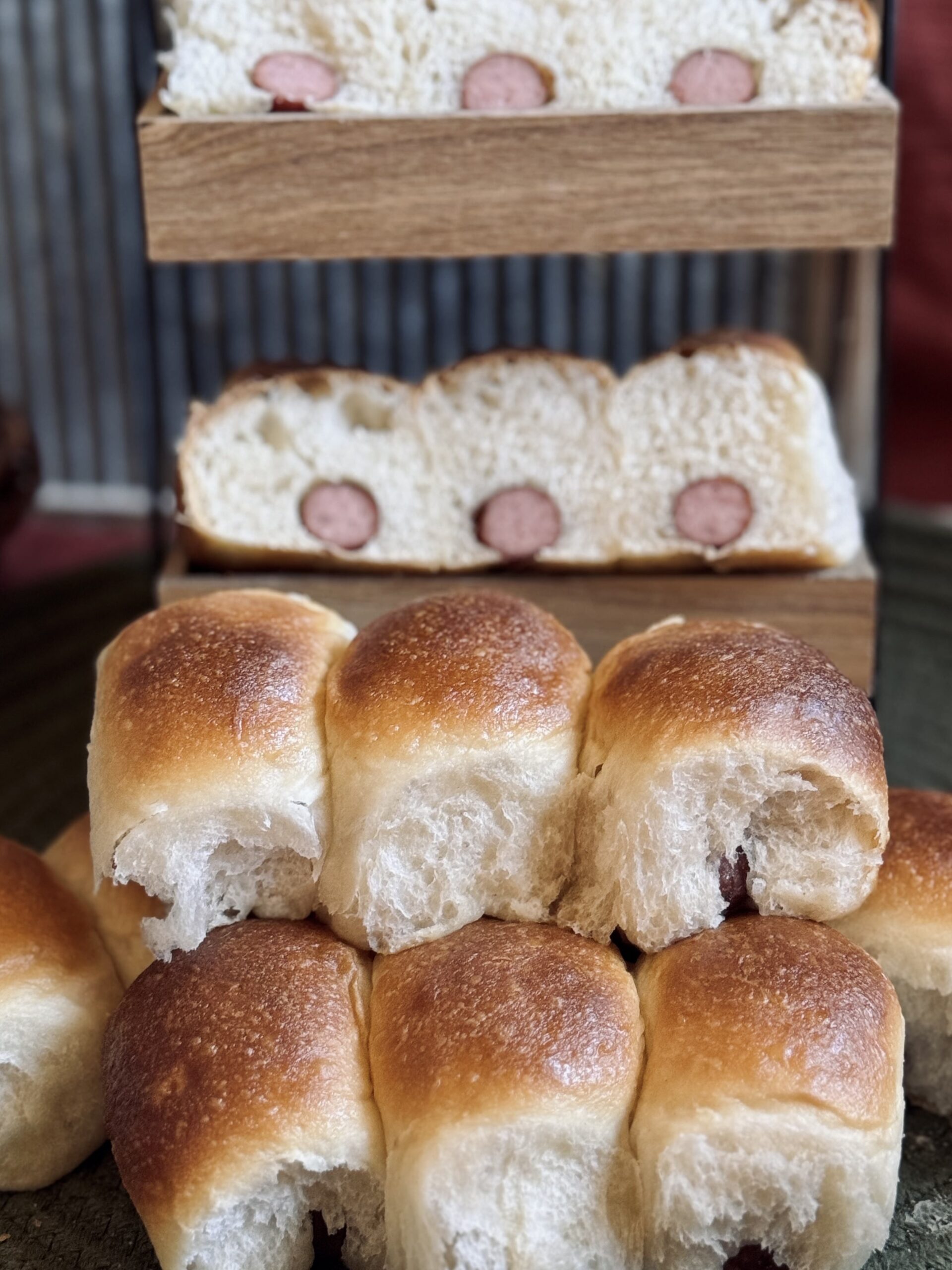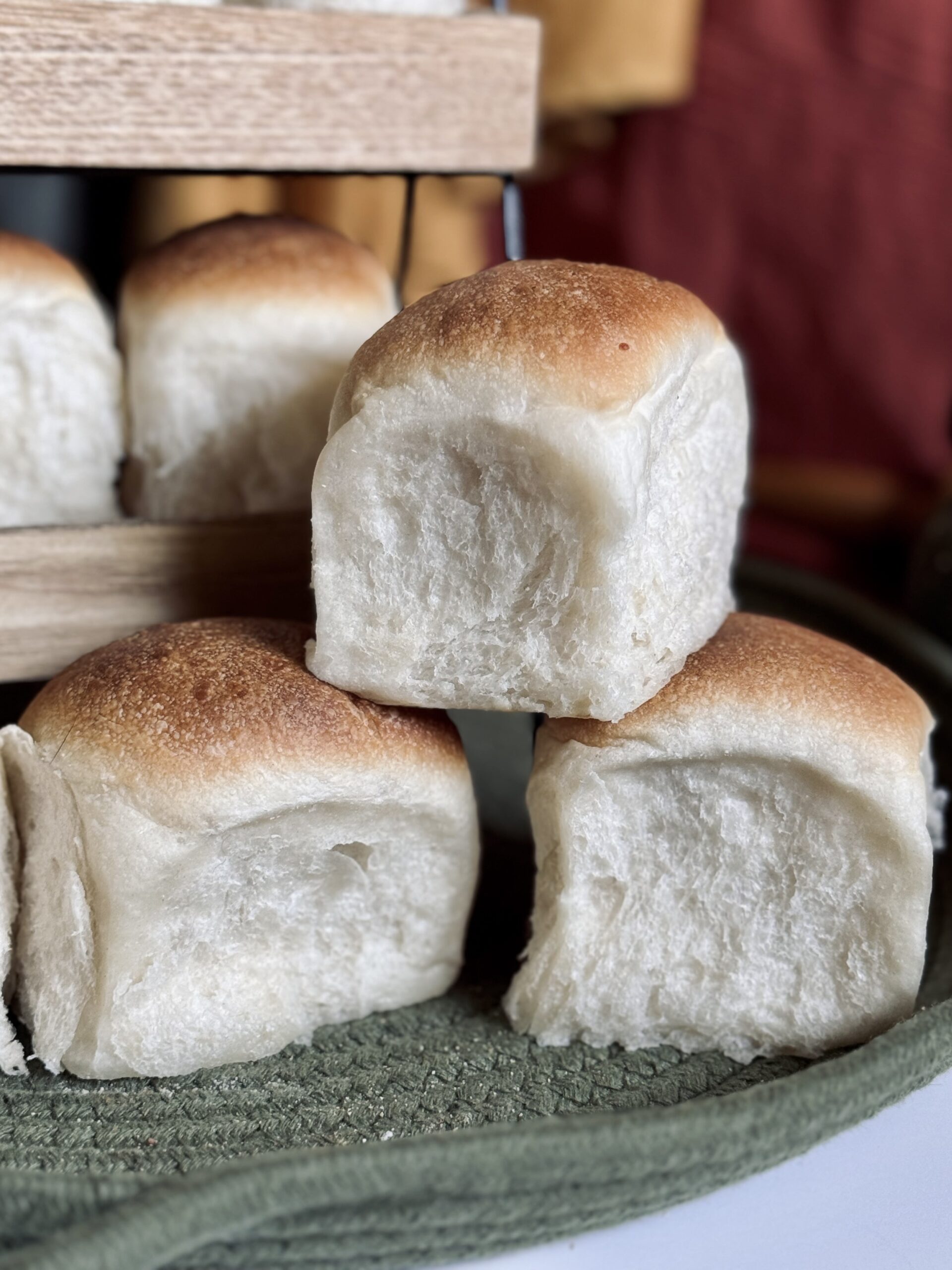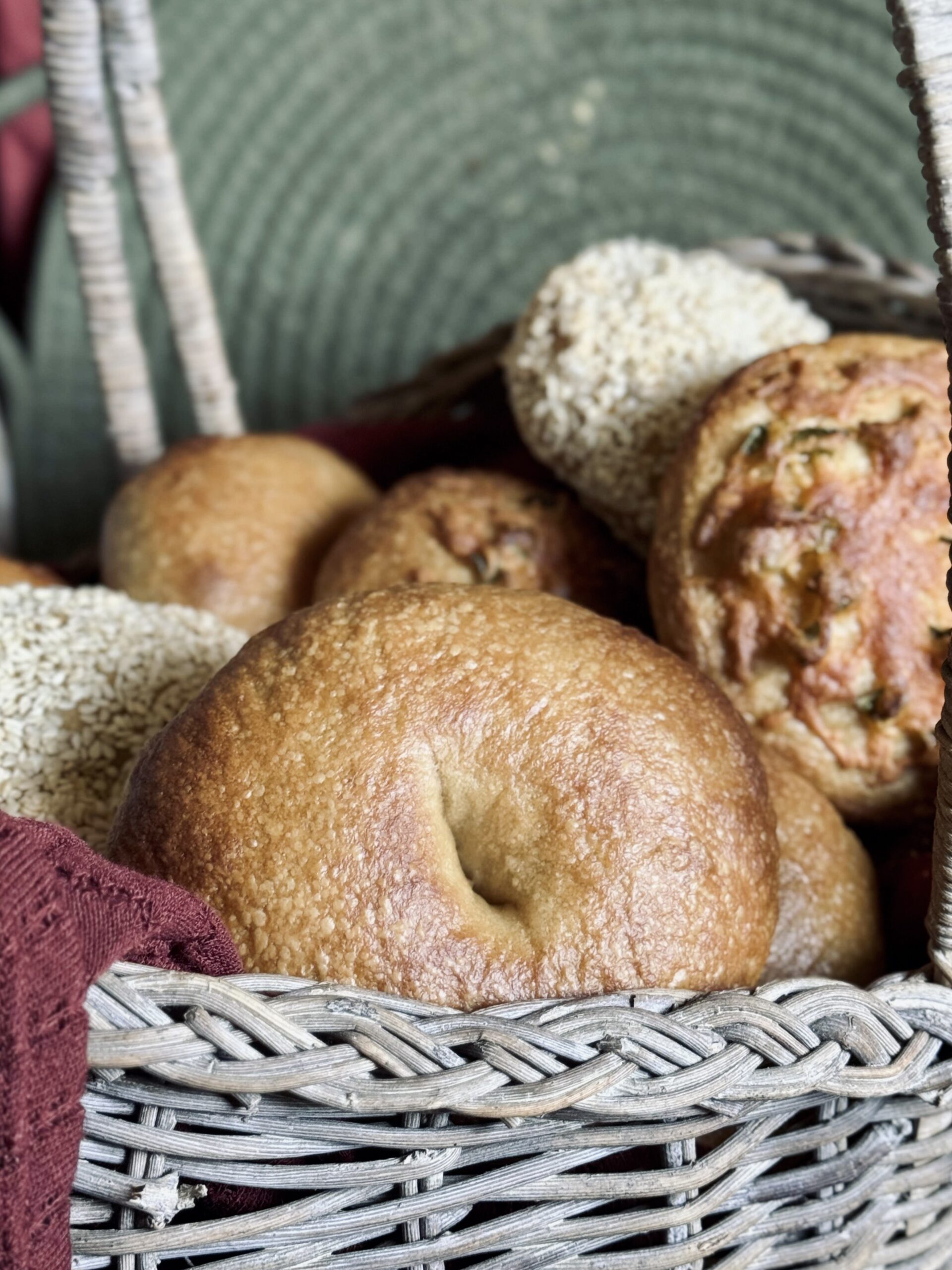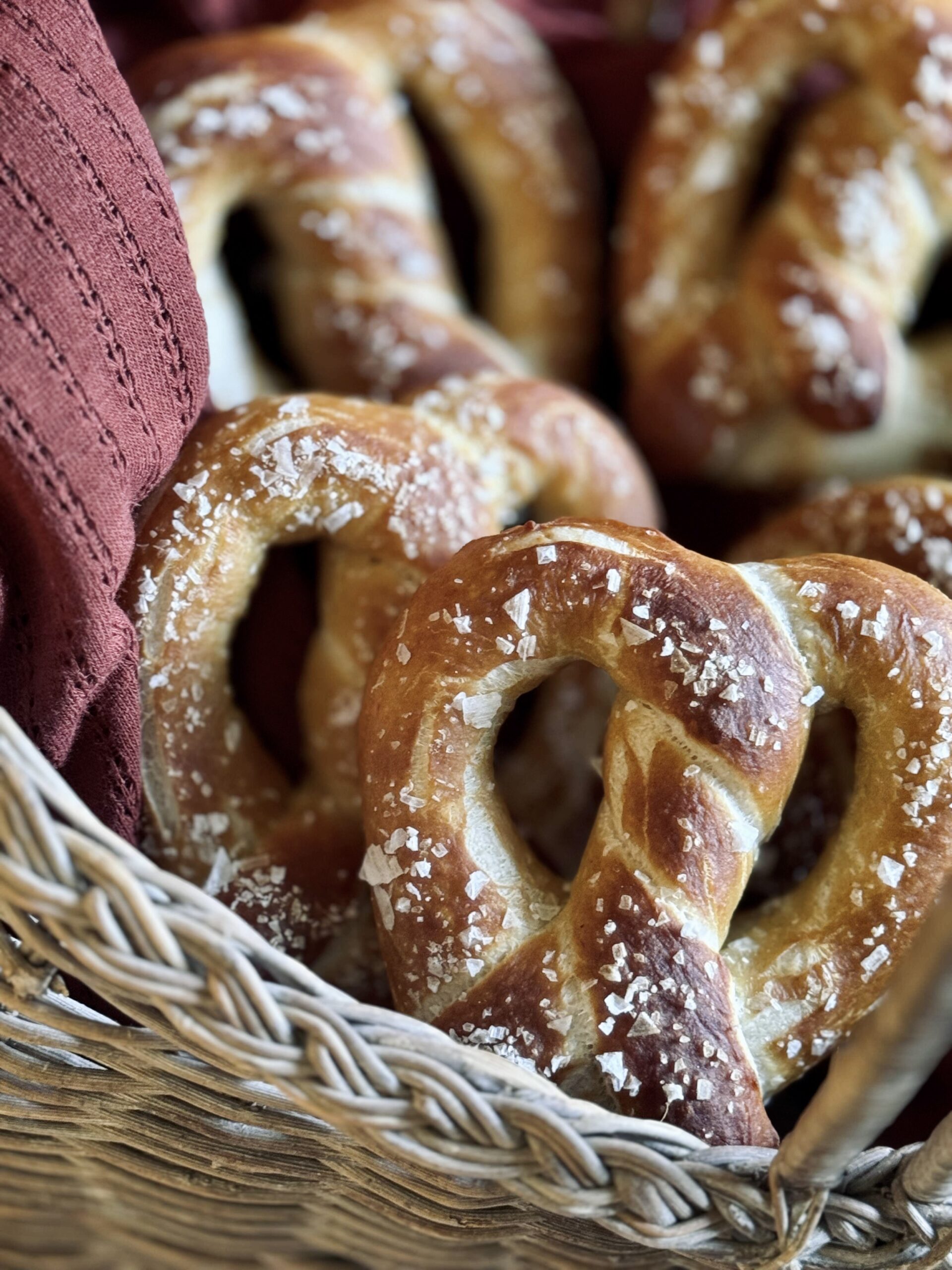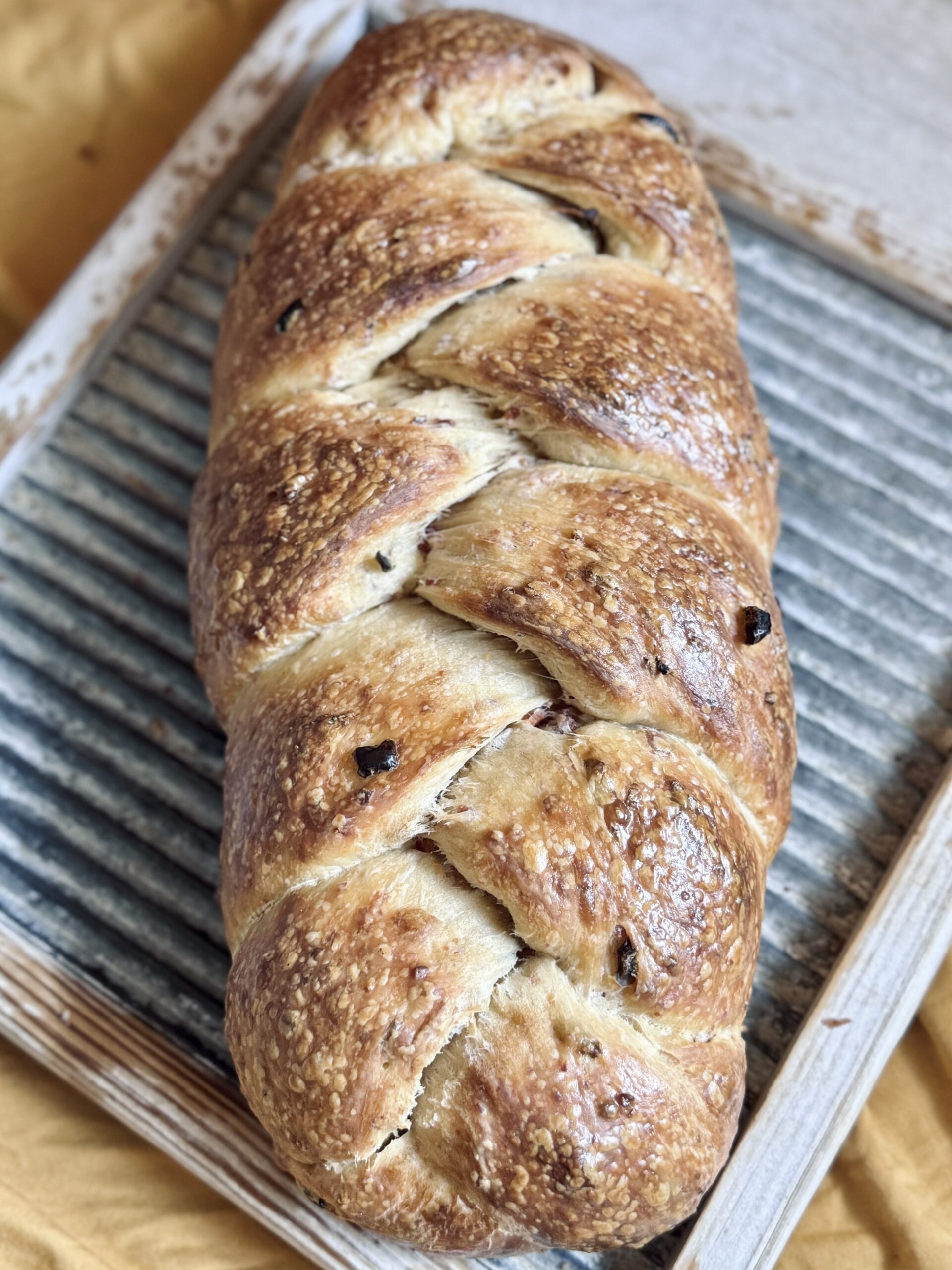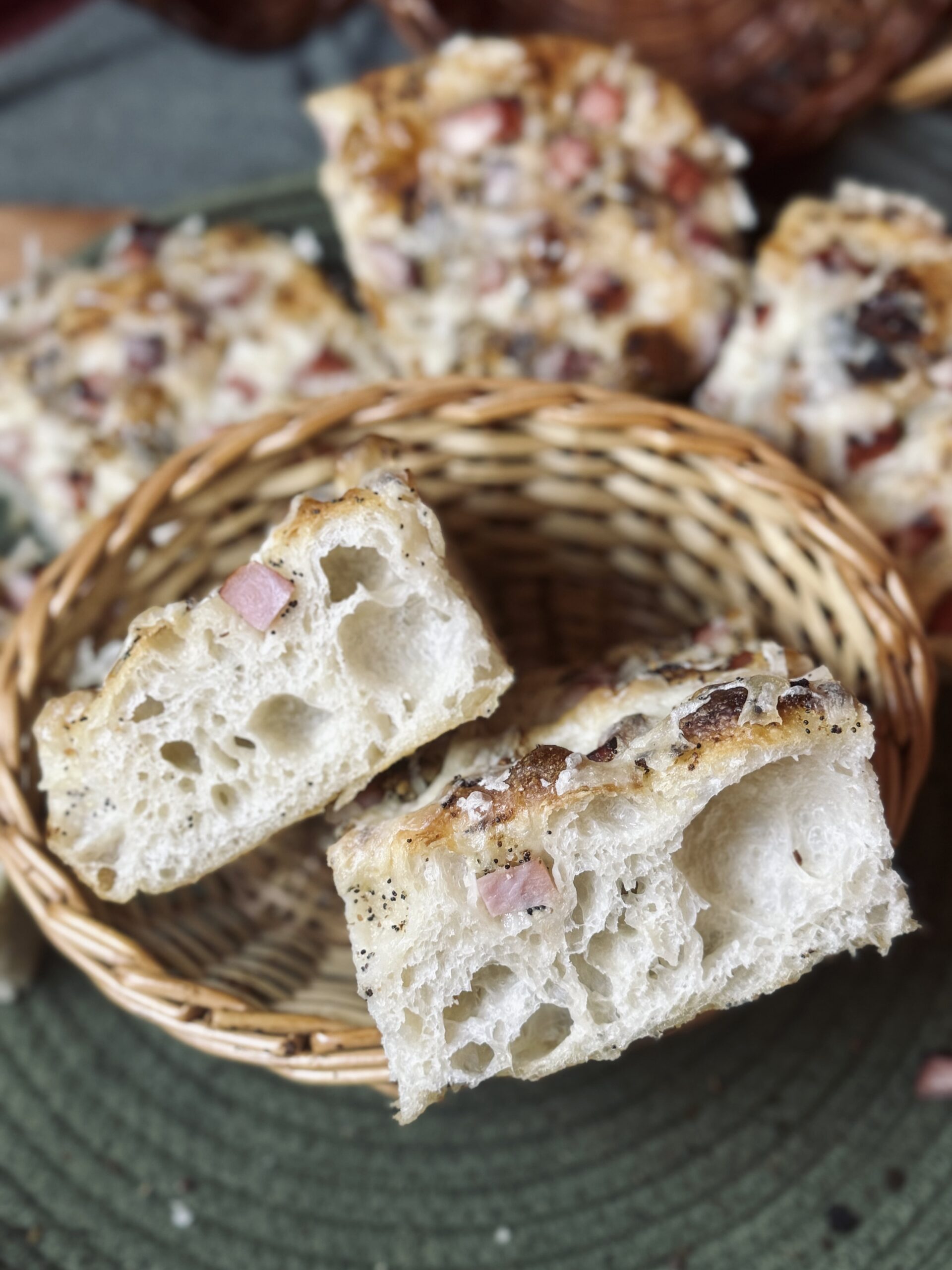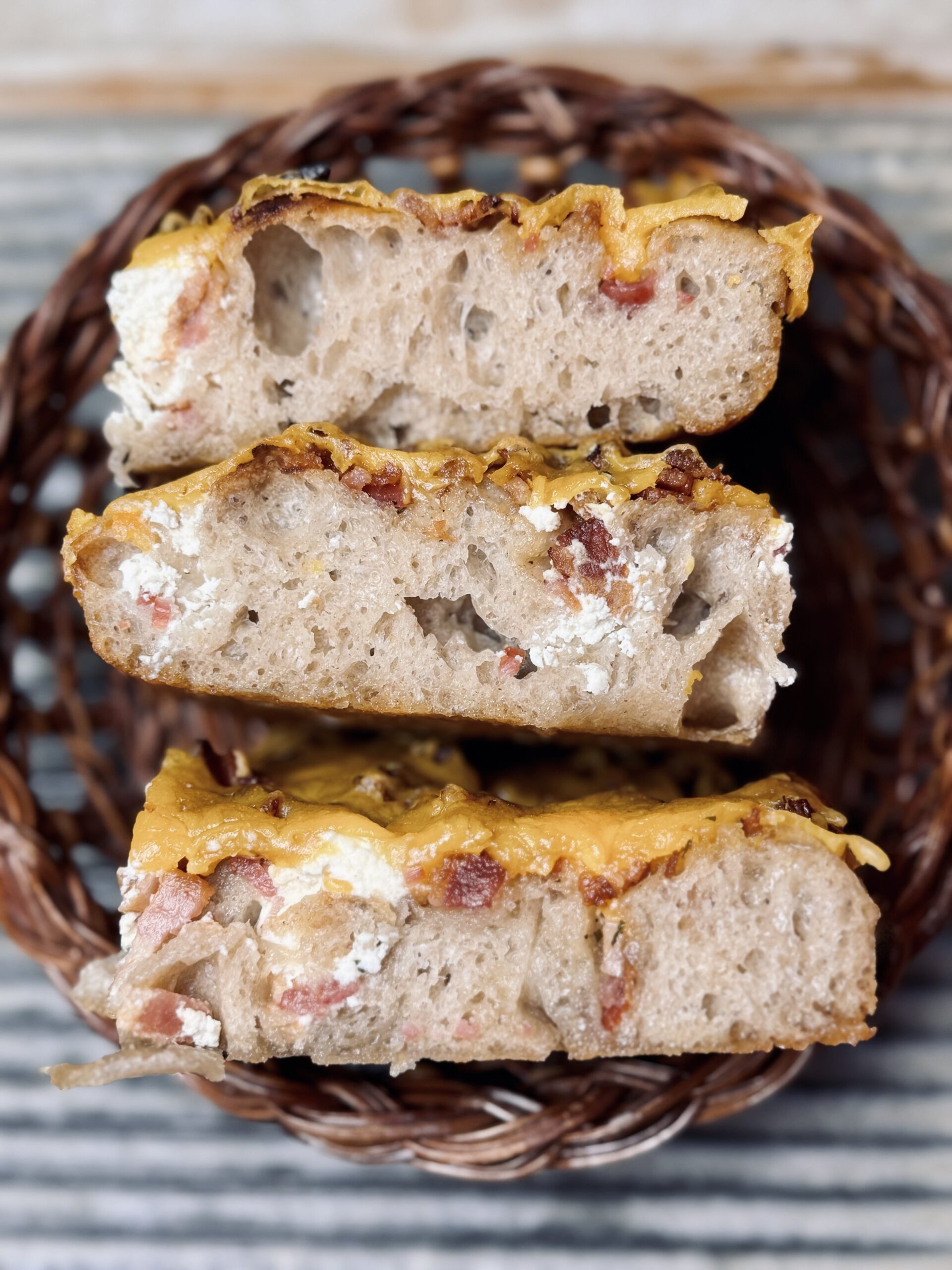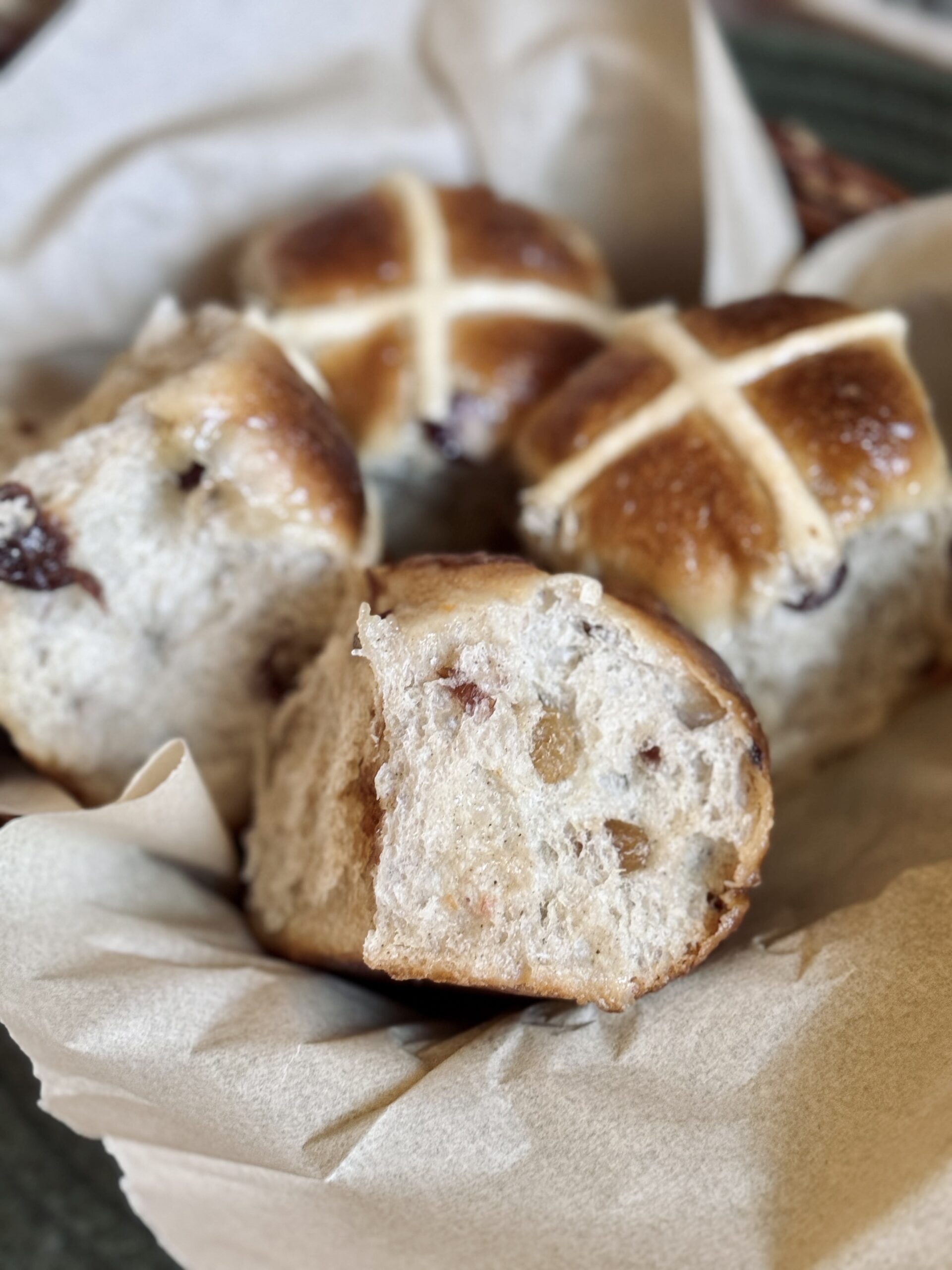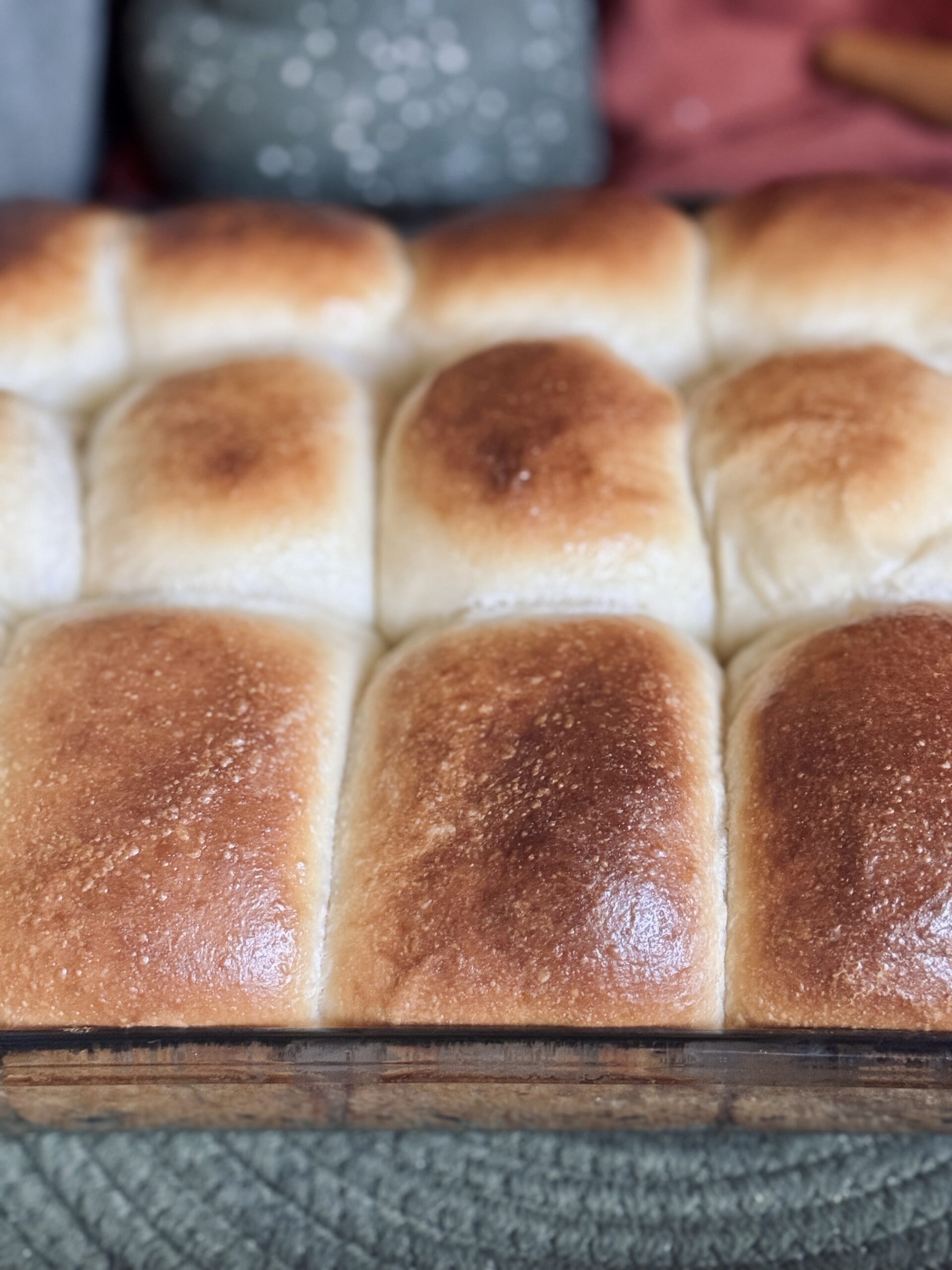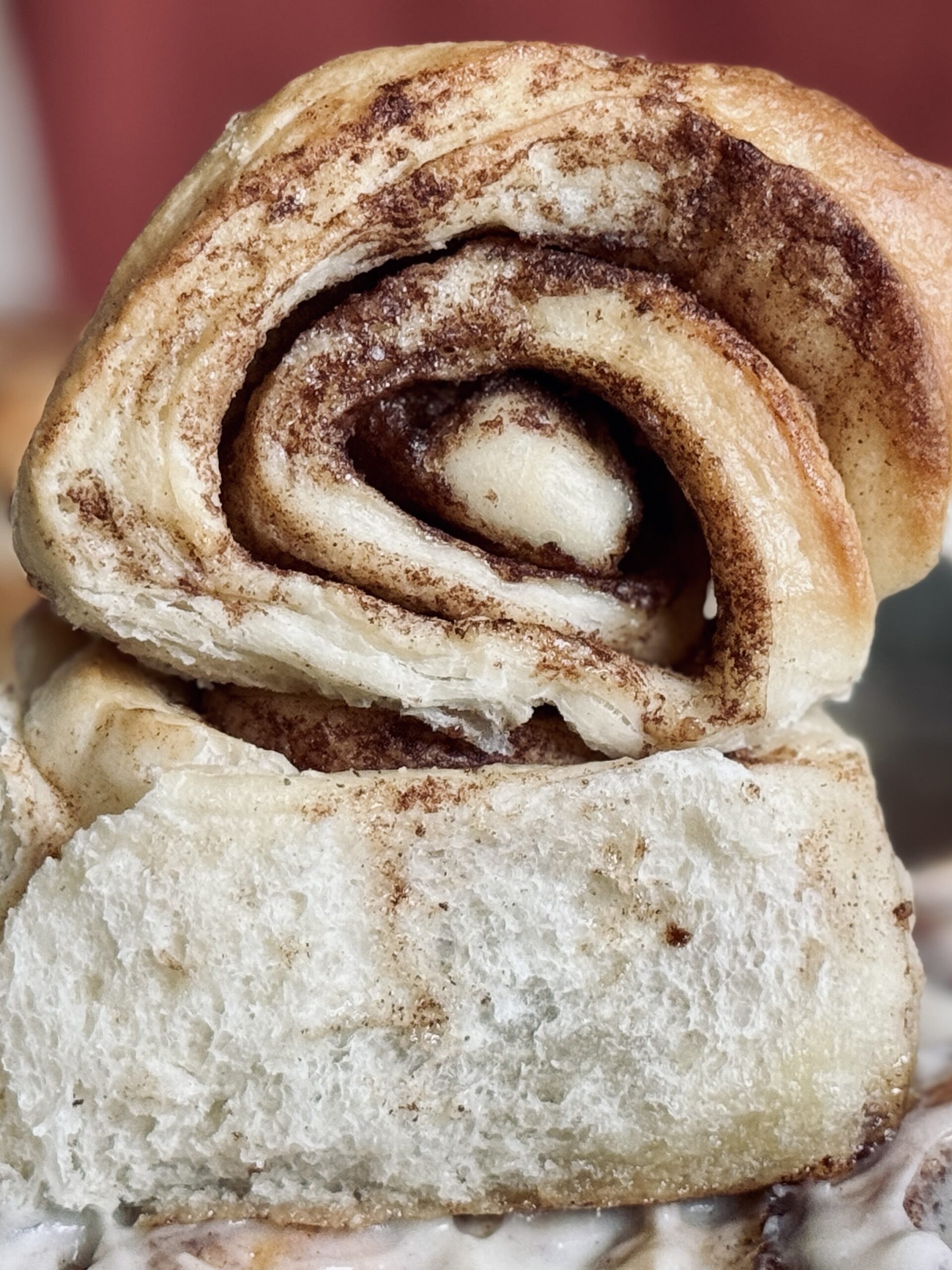About This Recipe
Sausage wrap rolls were a staple at the breakfast table of my childhood. My mom would buy them from our local grocery store, starting them in the oven early on weekend mornings, leaving their pleasant aroma to fume up the kitchen. These rolls are always a crowd pleaser. They are fluffy and tender, sweet with a savory bite of a cocktail sausage – a match made in heaven.
What Are Sausage Wrap Rolls?
Sausage wrap rolls are a cross between pigs in a blanket and a classic dinner roll. They consist of a mini sausage wrapped in a thin layer of enriched bread dough. These were made popular in the U.S. by Sister Schubert, who no longer sells the product. They were a classic holiday staple, potluck dish, or breakfast entree for many.
Considerations For Enriched Doughs
Enriched doughs, like sausage wrap rolls, contain ingredients that can make it difficult for gluten to come together. Fats (usually butter) and sugars in medium to large amounts mean it is necessary to develop the dough to a windowpane up front, in order to have the best fermentation experience. Without gluten, the dough simply cannot hold in air the same way. A dough that is not developed properly may taste flaky, like a biscuit, instead of tender or airy (as is the goal).
On a scale of 1-10, one being unenriched (like country bread) and 10 being heavily enriched (like panettone), this bread is about a “6” – it contains a medium-high amount of sugar and butter, but not an overly obnoxious amount. With any enriched dough, though, I always resort to my stand mixer for the best experience. You’ll find this dough needs 15-20 minutes of kneading to achieve a windowpane. Especially because of the addition of butter, I always find this process simpler and more efficient using my stand mixer.
Some home mixers are not built for kneading bread efficiently. Check the manual for your mixer, and be sure it is safe to endure mixing times of up to thirty minutes, just to be on the safe side. The most complicated bread in the bread-making world is panettone, which requires mixing times of up to sixty minutes. It is so very important not to overwork the dough or the motor on your mixer. I love my Ankarsrum stand mixer, which is more than capable of living up to the task of kneading even the toughest of doughs. If you do not own a mixer, it is possible to knead by hand, as long as you are willing to endure the task of kneading to a windowpane up front. You can use any preferred method, or find ideas in my video on methods of gluten development, here.
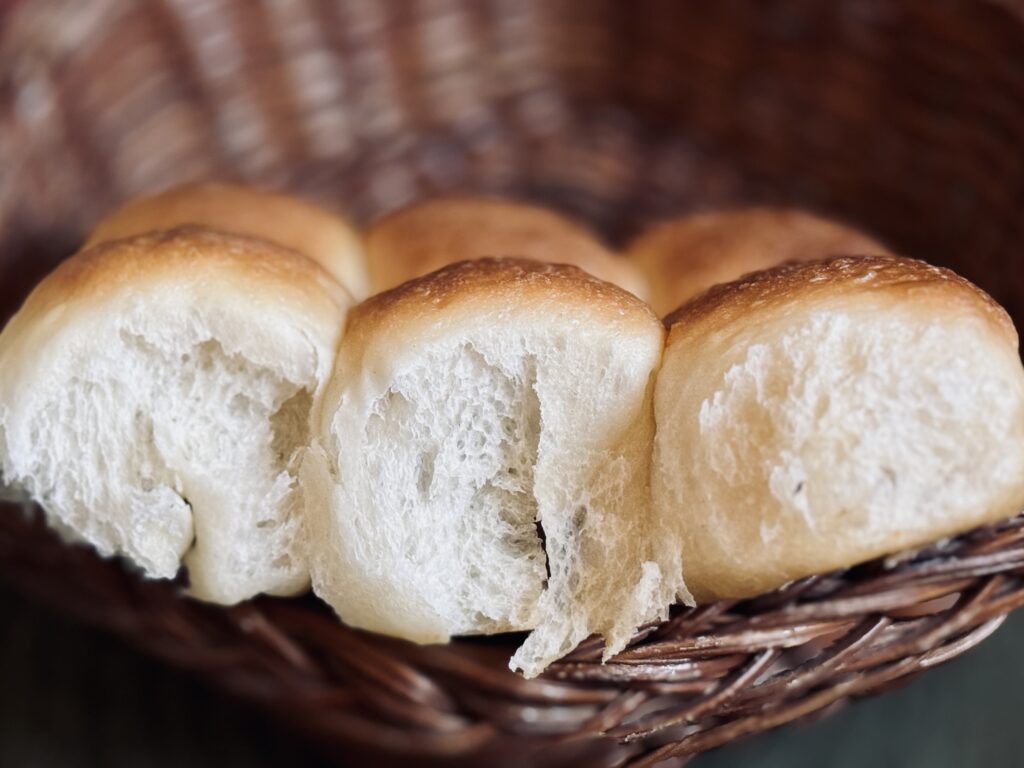
The “Why” Behind The Starter Build
Why Build A Starter (Levain) For This Recipe?
A “sour” flavor is not generally preferred for sweet breads. By building a levain, we can use a formula that helps to reduce overall sourness in the starter and in the bread. To do this, it is important to understand the starter, which consists of yeast and bacteria, and how the formula works to reduce sourness.
Sourness comes when bacteria are overpopulating in your sourdough starter, meaning they are out of balance with the yeast. This happens naturally, as bacteria reproduce faster than yeast do, especially in ideal climates. To limit sourness, it is important to favor the yeast in starter care. In this levain formula, I do just this in order to limit acidity and reduce overall sour flavor.
Stiff Starter
By giving the yeast more food (this means they can continue to eat, multiply, and produce CO2) and reducing the amount of water (bacteria favor wet climates), we can effectively reduce the amount of acidity in our starter at the same percentage of rise as a starter made with equal amounts of flour and water.
Sugar
This is one of the most important components of this levain – do not skip it! Sugar is a powerful tool. Added in low amounts, it feeds the yeast and speeds up fermentation. Added in high amounts, it dehydrates yeast cells and potentially stops fermentation altogether. Added in just the right amount, the yeast still thrive, but the bacteria suffer. 10-15% sugar in a recipe or levain creates something called “osmotic stress.” This stress to the bacteria limits their ability to reproduce, which limits acid buildup, thereby limiting overall sourness coming from the starter.
Temperature
In order to favor the yeast, I aim to keep this levain between 70-75 F (21-24 C) and use it when it has approximately doubled in size. Yeast produce most abundantly in these temperatures, while the bacteria in your starter (there are two types – lactic and acetic) favor temperatures both higher and lower than this. This specific temperature helps provide balance to the starter, which translates to how efficiently the starter ferments the bread and how mild the overall sour flavor is.
Optional Kneading
Have you ever heard of developing gluten in your starter? While it is not essential, kneading this starter for just a few minutes will help trap air, introducing oxygen and stimulating yeast growth. It also provides structure (by creating a slightly more elastic gluten network), which helps the levain rise and maintain peak more efficiently.
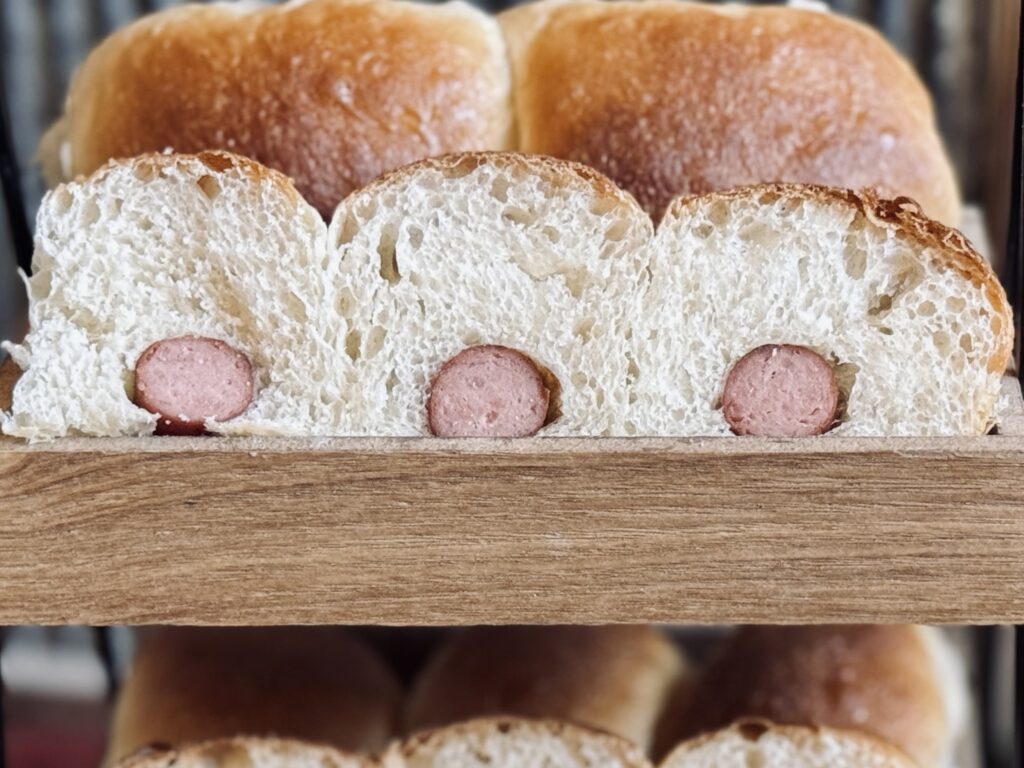
The “Why” Behind The Dough and Process
Milk Mixture
This is a technique that stems from the beginning of my bread journey, when I first started making bread doughs using commercial yeast. I have kept this technique for a long time. Recently, though, I have started to change this technique, moving away from heating my milk, butter, and sugar on the stovetop. This is because a well-kneaded enriched dough gains extra heat through friction during mixing; therefore, heating the ingredients is not necessary (and could even bring too much warmth to the dough, depending on your mixer). Despite this, let me tell you my previous reasoning as to why I created a “milk mixture” in this recipe:
By heating the liquid in the recipe with the sugar and the butter, we are able to simultaneously: a) create warmth that gets the yeast moving quicker, b) fully dissolve the sugar, and c) warm the butter without having to remember to soften a stick beforehand. There is not enough butter in this recipe to create greasy dough, as is the case with brioche, so melting (or, partially melting) it is definitely okay.
Let’s talk about the specific ingredients more in-depth:
Milk + Water
Milk is a tightening agent in bread, meaning it makes the gluten network stiffer and stronger, often increasing the time the dough ferments. This is because it takes twice the air to blow up a stiff balloon (our gluten network). However, it also adds a really good flavor and texture to dinner rolls. It makes the bread denser, softer, and creamier. It also helps the bread darken in the oven. For these reasons, I love to use milk in my sandwich bread recipes, but I also find it is best to balance the milk with water.
Water is the opposite of milk. It creates an extensible gluten network (loose, stretchy). It balances out the stiffness from the milk. It makes the dough lighter and airier. However, water does not really have a flavor and it doesn’t darken in the oven (unless you bake the bread at a really high temperature).
For these reasons, I like to balance these two ingredients accordingly, depending on the outcome I am trying to achieve. For a bread like this, milk is the winner for its tight, even crumb, flavor, and darkening capabilities. I use two parts milk to one part water to make this dough.
Sugar
This recipe contains a medium amount of sugar, roughly 24%. I definitely had to increase the percentage of starter in this recipe in order to accommodate these sweet rolls. This amount of sugar works to sweeten; however, it also has other effects -creating osmotic stress, which helps to reduce sourness, and pulling necessary moisture from the dough (which I have also accounted for in this recipe).
Butter
Butter is a tenderizer; it makes the dough fragile and soft. The amount of butter here is about 15% of the total weight of the flour, small enough to not interfere with the gluten network (too much), but large enough to help keep the bread soft during baking.
Bread Flour
Bread flour increases the strength (elasticity) of the gluten network, which is helpful for enriched doughs containing butter and sugar (ingredients that can interfere with gluten). Bread flour also helps the dough come together more efficiently when kneading, reducing the total amount of necessary mixing time. While I used to make this recipe with a blend of all-purpose flour and bread flour, I now use bread flour only, just for the incredible way it holds the dough together. I use King Arthur Bread Flour, protein content about 12.7%, in any recipe that calls for bread flour (unless otherwise noted).
Salt
Salt helps bring out flavor (without salt, bread would taste almost like nothing), but also has notable effects on the dough. Salt is a tightening agent, meaning it, in addition to milk, helps create a more elastic (strong) dough. It does slow fermentation, as well as gluten development, but these are things we must account for in the recipe because we cannot have a recipe without salt. It is important to use just the right amount, enough to bring out the flavor, but not so much that the loaf cannot ferment or come together. I use the standard – 2% salt – in all my recipes, unless otherwise noted.
Eggs
Eggs add moisture and fat to the dough, contributing to a tender texture. They help prevent the buns from becoming too dry, which is particularly important given the enriched nature of the dough. They also act as a binding agent, holding the dough together and providing structure. The proteins in eggs coagulate during baking, helping the buns hold their shape while maintaining a soft crumb.
Furthermore, eggs incorporate air during mixing, which contributes a better fermentation, creating a lighter and fluffier texture. Last, eggs enrich the dough, adding a subtle richness that complements the sweetness of these rolls.
Mixing
Because butter and sugar can interfere with gluten’s natural ability to come together over time, it is preferable to knead this dough to complete development up front. That’s why I choose to use a stand mixer – because the process for this can be kind of enduring by hand (though it is possible). Using a stand mixer ensures a perfectly and effectively built dough with minimum effort on the baker’s part. Watch this video for all the ways to develop gluten in your bread.
I want to be more specific in this updated post about how to develop the dough properly in the stand mixer than I was when I originally published this recipe. This way, you can be successful mixing this dough using any stand mixer, or even by hand.
The ultimate goal: to knead this dough to a windowpane. When you pull up on a section of dough, it should not tear. You should be able to stretch the dough to a point where you can see through it before it breaks. The dough will show other signs of being ready, too, such as clinging to itself or forming a ball around the dough hook. If you have a KitchenAid or similar mixer, the stand mixer may start to “jump” when the dough builds sufficient strength.
The first step to achieving this is to mix the dough on a low to medium-low speed until the ingredients are fully combined and the mixture forms one cohesive mass of dough. This step simply brings our dough together and hydrates the proteins in the flour before the speed is increased and the focus shifts from combining ingredients to forming gluten. Too fast a speed during this initial mix can start to organize gluten that is barely created, negatively impacting the development of the dough.
Next, we increase the speed and knead the dough until it forms a windowpane. The speed you choose is up to you and what your mixer (and dough) can handle. The basic guidelines are this:
- A lower speed will take longer, while a higher speed will knead the dough much faster.
- A lower speed will keep the dough elastic (strong, not stretchy), while a higher speed will create extensibility (stretchiness).
- The dough temperature should not exceed 78 F (26 C).
- Use the guidelines from your mixer to determine what it is able to handle.
Bulk Fermentation
Letting the dough rise as much as possible, but not too much, contributes to the airiest of loaves. In an attempt to favor the yeast and reduce sourness, I recommend keeping the dough temperature between 70-75 F (21-24 C). Watch the dough and ferment until it triples in size (about twelve hours – trust me on this one). If you developed the dough well in the stand mixer, it should be able to hold this heavy fermentation. Though I favor an overnight method for this dough, use your knowledge of your environment to bulk ferment this dough appropriately.
The Filling
I bake my sausages before wrapping them in order to dispense any excess grease/moisture that might prohibit the rolls from baking properly in the oven. I prefer the flavor of all-beef sausages, but you can use what you like.
Shaping
This dough is sticky; therefore, it can be helpful to use water, oil, or flour to help with shaping. You may also choose to chill this dough in the refrigerator for a couple hours before shaping as well. I usually choose to use a small bowl of water to dip my fingertips as necessary, though it is important not to oversaturate the dough as you are working with it. Other times, I lean toward a light dusting of flour.
These rolls might seem tricky to shape; however, with the right technique they are so easy. Shaping begins by dividing and forming each section into a round, like an ordinary dinner roll, that is then elongated and wrapped around the sausage. Sometimes the gluten is a little tight after forming the round. In this case, it can be helpful to let the piece of dough you are working with rest while you shape a few more pieces of dough. Then, you can just go right back to it. The dough will stretch and wrap around the sausage much more easily.
The Wash
For this recipe, I chose a honey-butter wash over other options. Butter keeps the rolls soft, while honey adds sweetness and a light brown color. If you ferment these rolls long enough, they will brown beautifully in the oven (see below) without a wash. If under-fermented, they may not brown properly at all. Alternatives to the honey-butter wash include: a simple butter wash (which leans toward softness only) or an egg wash (one whole egg whisked until smooth, which leans toward a darker color only).
Baking
I bake my milk breads (like this one) at a lower temperature than my water-based breads, usually 350 F (175 C). However, I want these rolls to achieve a deeper brown color in the oven; therefore, I bake them at 375 F (190 C). This “low and slow” temperature is meant to prevent over-browning and over-baking. A final internal temperature of 185 F (85 C) cooks these rolls until they are just done, leaving you with the softest and fluffiest end result.
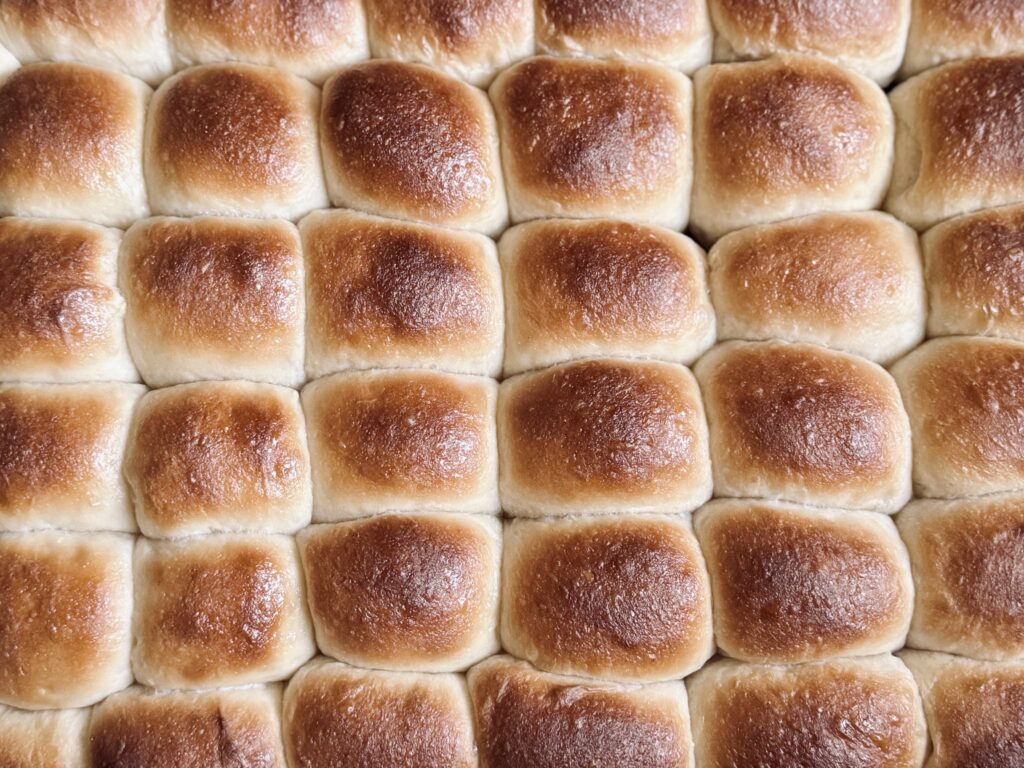
Suggested Timelines
Overnight Timeline
DAY 1
9:00 a.m.
- Make the sweet stiff starter.
9:00 p.m.
- Mix and knead the dough.
- Bake the sausages and store in the fridge (option 1).
9:30 p.m.
- Begin bulk fermentation.
DAY 2
8:30 a.m.
- Bake the sausages (option 2).
9:00 a.m.
- Shape the dough.
12:00 p.m.
- Wash and bake the rolls. Enjoy!
Refrigeration Timeline
DAY 1
9:00 p.m.
- Make the sweet stiff starter.
DAY 2
9:00 a.m.
- Mix and knead the dough.
- Bake the sausages and store in the fridge (option 1).
9:30 a.m.
- Begin bulk fermentation.
9:30 p.m.
- Transfer dough to the refrigerator overnight.
DAY 3
8:30 a.m.
- Bake the sausages (option 2).
9:00 a.m.
- Shape the dough.
3:00 – 5:00 p.m.
- Wash and bake the rolls. Enjoy!
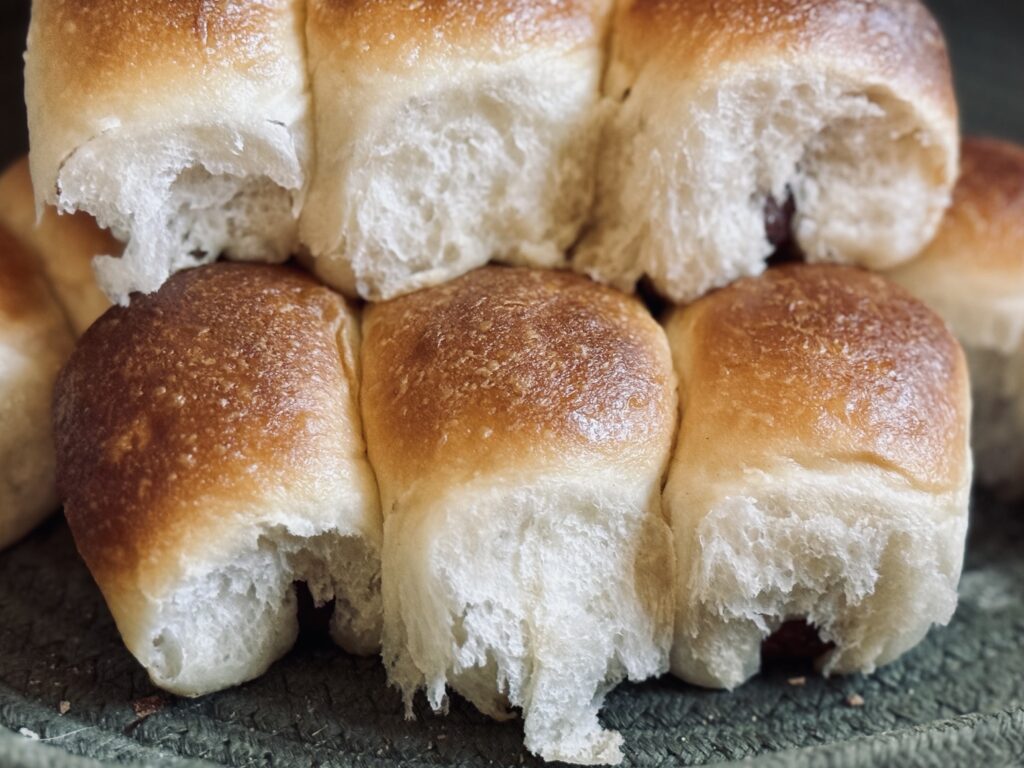
📌 Quick Tip: Read the recipe in its entirety before you start cooking. This will help you understand the ingredients, steps, and timing involved, and allow you to prepare any necessary equipment or ingredients beforehand.
Sausage Wrap Rolls
Ingredients
Sweet Stiff Starter
Milk Mixture
Main Dough
Filling
Wash
Instructions
-
Make the sweet stiff starter.
Mix together all ingredients for the sweet stiff starter 8-12 hours before beginning this recipe. Cover and rest at room temperature.
-
Warm the milk mixture.
In a separate, small saucepan, combine milk, water, sugar, and butter. Heat the mixture until it reaches 95 F (35 C), the sugar is dissolved, and the butter is partially melted. Cool slightly before incorporating into the dough.
-
Begin the main dough.
Whisk together the flours and salt in the bowl of a stand mixer. Add the milk mixture and give it a rough stir. Last, add all of the sweet stiff starter and two eggs. Transfer to a stand mixer fitted with a dough hook attachment.
-
Knead the dough.
- KitchenAid: Knead on a medium speed (speed 4-6) 10-15 minutes, until the dough pulls away from (and “slaps”) the sides of the bowl and forms a ball around the dough hook. I kneaded on speed 6 for eight minutes, then slowed to speed 4 for five more minutes.
- Ankarsrum: Using the dough hook and scraper attachments, knead on a medium speed (speed 3-4 o'clock) 12-15 minutes, until the dough becomes strong enough to climb up the dough hook and push the scraper away from the side of the bowl.
-
Bulk ferment.
Transfer the dough to a proofing container and let it rise until it has tripled in size. This will take about 12 hours at 70 F (21 C), so I love to do this as an overnight dough.
-
Bake the cocktail sausages.
Pre-bake forty-two cocktail sausages at 350 F (175 C) for twenty minutes. In my opinion, this makes them taste better and allows the opportunity for grease to dispense before the sausages are wrapped and baked in the dough. Dot the sausages dry with a paper towel or cloth before wrapping.
This step is optional. -
Shape.
After the dough has risen, prepare a bowl of water for dipping your fingertips or dusting of flour on the counter to prevent the dough from sticking. Turn the dough out onto a working surface and divide into forty-two sections, 35-40 g each.
-
Shape each section into a round, dipping your fingertips in the water or dusting lightly with flour as necessary, by tucking all the ends underneath the dough in a circular motion. Turn the dough bottom side up and stretch the dough to elongate it enough to wrap around each cocktail sausage. Place the wrapped sausages, seam side down, on a half-size sheet pan, creating seven rows of six sausages each.
You can give the dough a rest after you have shaped the round if it is feeling tight. Shape a few more rounds, then come back to the original piece of dough. It will stretch and wrap around the sausage much easier. -
Final proof.
Let the wrapped sausages rise 2-4 more hours, until they are very puffy and pushing up against one another (about double in size once more).
-
Preheat your oven to 375 F (190 C).
-
Make the wash.
Whisk together the melted butter and honey for the wash. Brush all over the proofed sausages before baking.
-
Bake the rolls.
Bake for 25-30 minutes, until the internal temperature registers 185-190 F (85-88 C). Enjoy!
Servings 21
- Amount Per Serving
- Calories 382.17kcal
- % Daily Value *
- Total Fat 19.42g30%
- Saturated Fat 7.72g39%
- Trans Fat 0.05g
- Cholesterol 68.7mg23%
- Sodium 400.35mg17%
- Potassium 216.26mg7%
- Total Carbohydrate 38.85g13%
- Dietary Fiber 0.9g4%
- Sugars 12.52g
- Protein 13.05g27%
- Vitamin A 73.6 IU
- Vitamin C 0.01 mg
- Calcium 28.35 mg
- Iron 2.24 mg
- Vitamin D 0.94 IU
- Vitamin E 0.84 IU
- Vitamin K 0.8 mcg
- Thiamin 0.41 mg
- Riboflavin 0.3 mg
- Niacin 5.36 mg
- Vitamin B6 0.11 mg
- Folate 16.75 mcg
- Vitamin B12 0.56 mcg
- Phosphorus 124.16 mg
- Magnesium 18.8 mg
- Zinc 1.43 mg
* Nutrition values are auto-calculated and should be used as an approximation only. In addition, the values may not accurately represent the serving divisions of the recipe, instead representing the nutrition of the recipe as a whole.
Notes
- Storage: Store in the refrigerator three to five days, or in the freezer. Microwave to warm.

